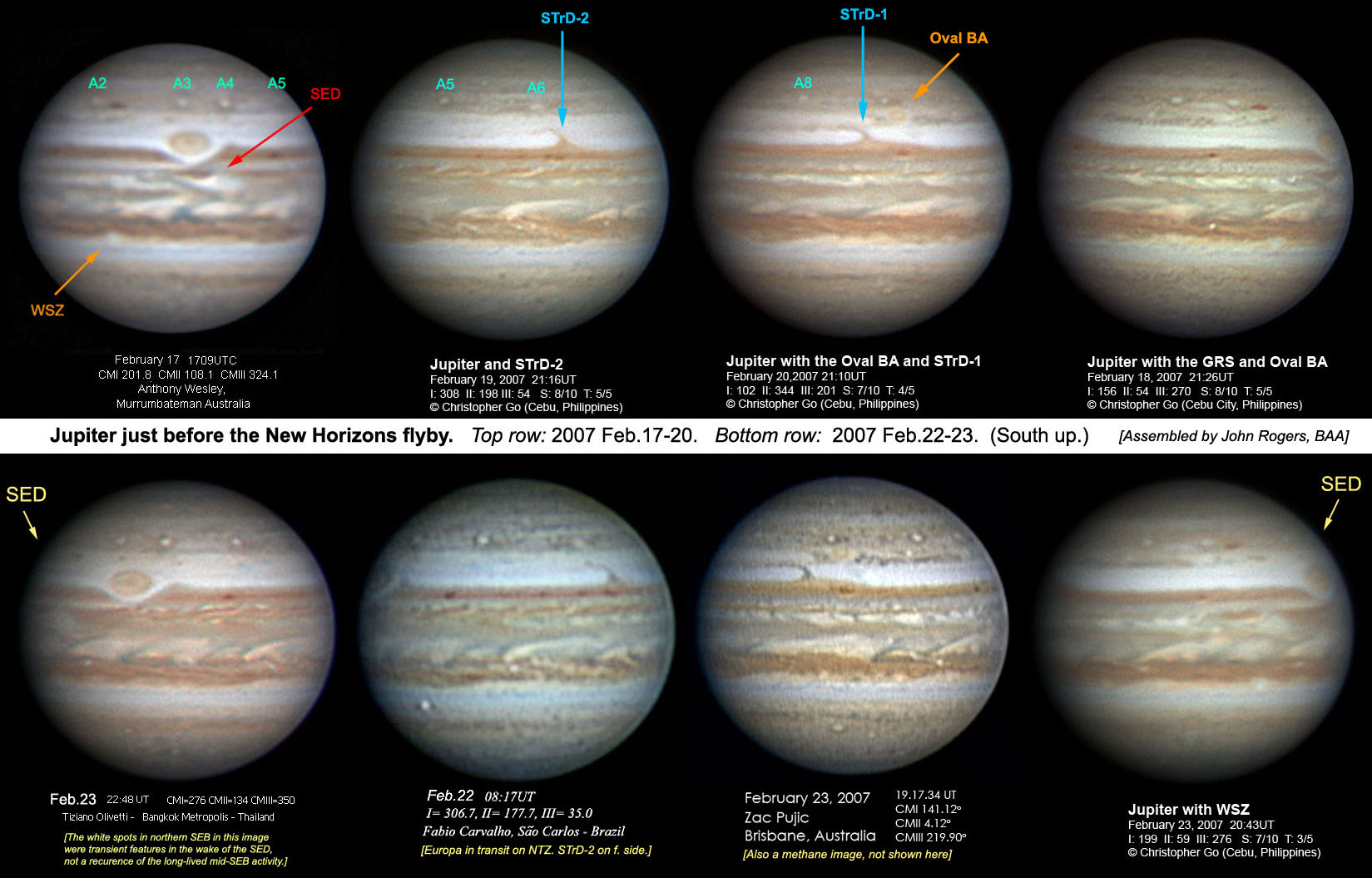
[2]
Jupiter
in 2007 - Second Report
(report, 2007
Feb.19th)
Jupiter
in 2007: second report
Here
is a quick update as the New Horizons flyby on Feb.28 approaches. Some amateur
observers have now been able to get enough good images that we can predict where
the main features of interest at that time.
Thanks to Fabio Carvalho (Brazil), Tiziano Olivetti (Thailand), Chris Go
(Philippines), and Anthony Wesley (Australia), for these images.
The following drift rates are approximate, as they are derived partly
from my manual measurements on these images (which will be superceded when the
JUPOS team have completed their work), and partly from measurements on the early
New Horizons images which I fitted to an assumed track for SSTB-oval-A8.
EZ(S),
SED, and SEB:
The
EZ and SEB appear dramatic, with much shading and coloration.
In the EZ, there is an intricate mixture of blue-grey festoons with the
broad brownish EB that developed during 2006.
The EZ(S) is very disturbed, largely due to the S. Equatorial Disturbance
(SED).
The
main complex of the SED is now (Feb.18-19) passing the GRS. It now appears as a
great white spot, as in the Voyager era; this is a spectacular transformation of
the feature that we have tracked since 1999. Apparently its appearance owes more
to the surrounding cloud patterns than to its internal dynamics. There is much
disturbance p. it, which looks like (and may be) a series of great waves; the
most obvious is a second large white patch 30-40 deg. p. the main complex.
The movement of the SED seems to be variable (as has been noted before
when it is very active): its drift DL1 was ~+22 deg/mth from 2006 May to Dec.,
then >+30 deg/mth in mid-Jan., but only ~ +20 deg/mth now.
Following
the SED is a prominent dark reddish sector of SEB(N).
Elsewhere SEB(N) is quite narrow, and there is an extensive SEBZ: perhaps
this will develop into general fading of the SEB later this year?
(The SEB is internally still quiet.)
In
contrast the SEB(S) is strikingly dark red. Perhaps this is part of the same
coloration event that started with dull shading in the EZ in 2006 and has spread
southward, intensifying over the SEB? The
few 'mini-barges' within it have become very prominent, very dark red, in hi-res
images. One is f. the GRS and one has just passed STrD-1.
STropZ
and STB circulations:
STrD-1
and -2 persist as prominent features, both now prograding in L2 as expected.
They were well shown in the early pairs of New Horizons images, but the
circulations still could not be clearly resolved, apart from one pair of images
which seemed to show the expected anticlockwise circulation at the f. edge of
STrD-2. Hopefully the close
encounter images will show STrD-1 much better.
STrD-1
split into separate p. and f. components, both with variable drift, and the f.
one faded away as oval BA passed it, leaving just a faint outline behind on
Feb.10-13. About the same time,
oval BA seems to have accelerated. These changes may all have been connected.
The p. edge of STrD-1 had also accelerated to DL2 = -8 (+/-2) deg/mth; it will
be interesting if it and oval BA move as a coupled pair in future.
John
Rogers
2006 Feb.18
